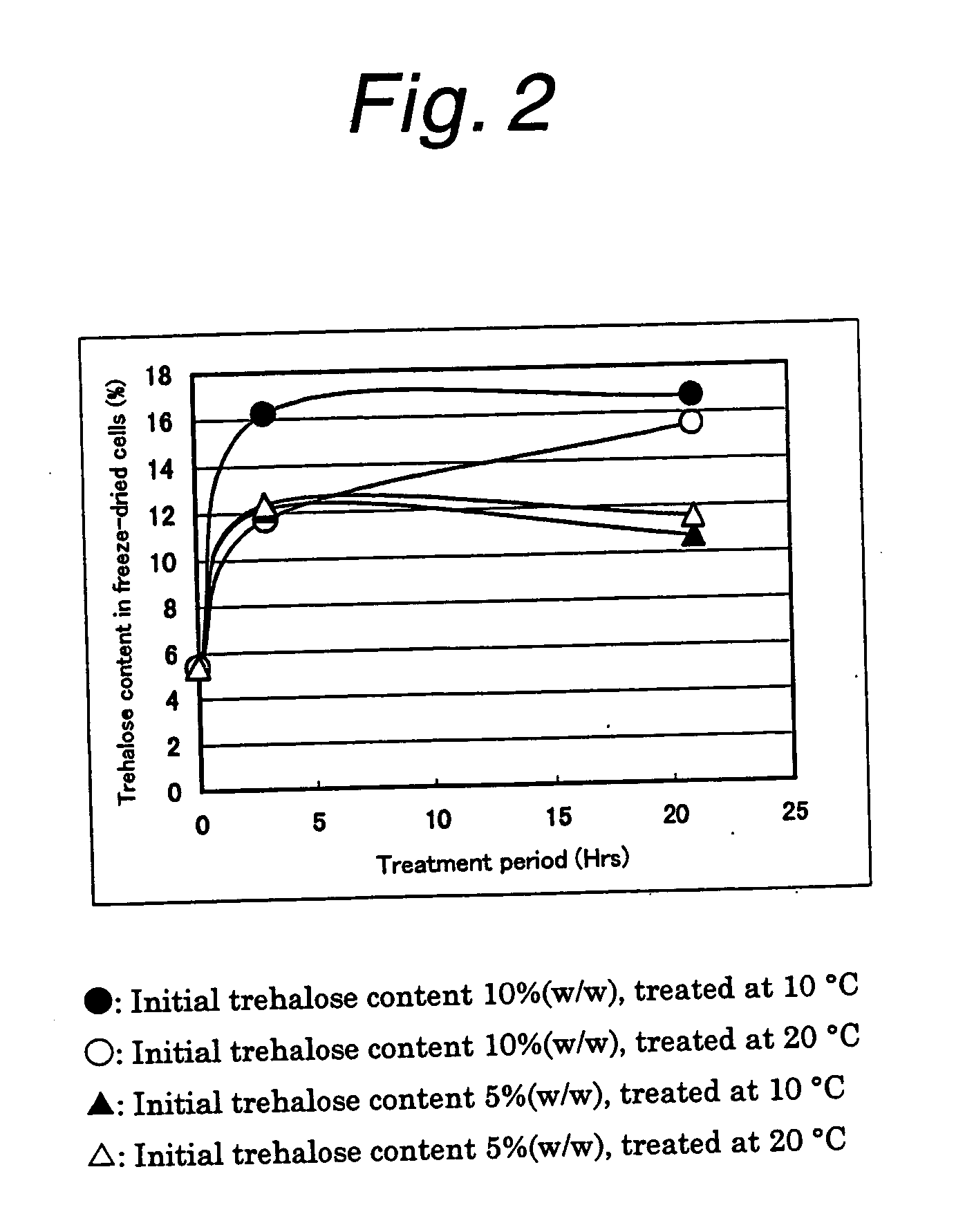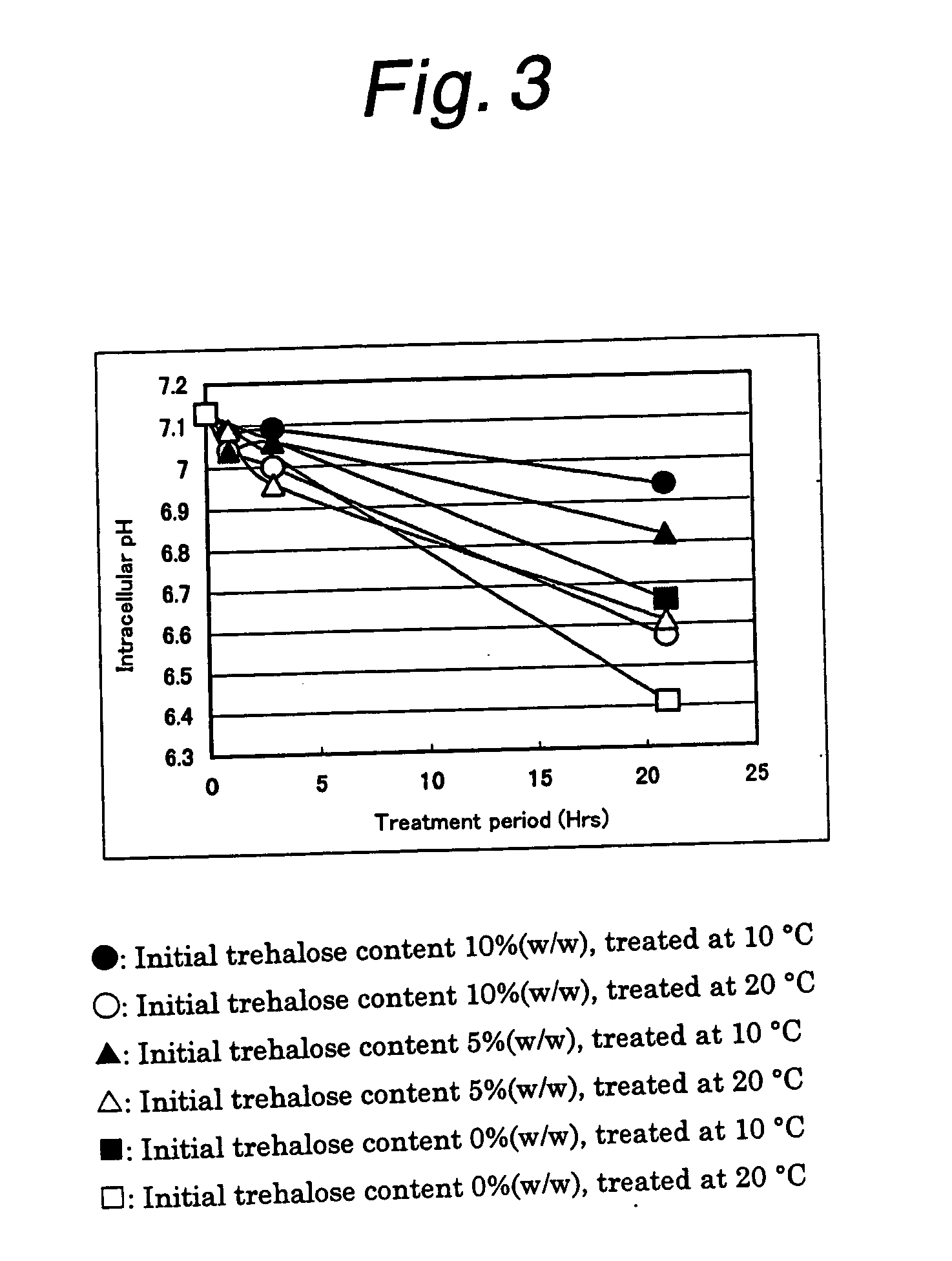Method of producing active dry yeast
a technology of dry yeast and yeast cells, which is applied in the field of producing dry yeast, can solve the problems of reducing the survival rate of yeast, affecting the quality of alcoholic beverages obtained, and no real practical or satisfactory method has been developed so far, and achieves the reduction of mortality, the survival ratio is satisfactory, and the water activity in the yeast cells is low.
- Summary
- Abstract
- Description
- Claims
- Application Information
AI Technical Summary
Benefits of technology
Problems solved by technology
Method used
Image
Examples
example 1
[0051] Ability to Incorporate Trehalose and Activity of Recovered Yeast
[0052] 50 g of a slurry yeast recovered from the beer fermentation step (hereinafter referred to as the recovered yeast) was treated with trehalose by adding 50 g of a 10% (w / w) or 20% (w / w) aqueous trehalose solution and stirring. After mixing with the recovered yeast, the trehalose-treatment liquids respectively contained 5% (w / w) and 10% (w / w) of trehalose. The trehalose-treatment was carried out at 10.degree. C. or 20.degree. C. The trehalose-treatment liquids were sampled with the passage of time and each sample was centrifuged to thereby separate into cells and a supernatant. The trehalose content in the supernatant was measured by liquid chromatography with the use of a Shim-pack CLC-NH2 column (manufactured by Shimadzu Corporation). By using the wet cells, the intracellular pH value was measured by .sup.31P--NMR in accordance with a publicly known method (European Brewery Convention 26.sup.th Congress, EB...
example 2
[0055] Improvement in Resistance to Drying by the Incorporation of Trehalose
[0056] 50 g of a 20% aqueous solution of trehalose was added to 50 g of the recovered yeast and the resultant mixture was stirred at 20.degree. C. for 3 hours to thereby incorporate the trehalose into the yeast cells. Then the yeast having trehalose thus incorporated was filtered under suction on a filter paper No.2 with the use of a Nutsche filter. The obtained yeast was then passed through a 14-mesh sieve and dried in a thermostat at 30.degree. C. for about 20 hours to give a dry yeast. 0.1 g of this dry yeast was suspended and reconstituted in 1 ml of distilled water at room temperature. Then the mortality of the yeast was measured by the Methylene Blue staining method. Since dead cells could not reduce Methylene Blue, the cells stained with Methylene Blue were regarded as dead cells. Thus, the Methylene Blue staining ratio could be referred to as the mortality. As FIG. 1 shows, in a case where a dry yeas...
example 3
[0058] Improvement in Storage Properties by the Incorporation of Trehalose
[0059] 250 g of the recovered yeast was suspended in the same weight of purified water or a 20% aqueous solution of trehalose and then maintained at 5.degree. C. for about 2 weeks. The trehalose contents in the supernatant and in the cells and the intracellular pH values were monitored with the passage of time as in Example 1. When the trehalose content in the supernatant was measured by the method described in Example 1, the trehalose content was lowered from 10% at the initiation of the treatment to 4% on the day 7 due to the incorporation into the yeast, as FIG. 4 shows. Since the trehalose content in the supernatant was lowered to 2% on the day 8 after the initiation of the treatment, the yeast under the trehalose-treatment was separated by centrifugation and suspended by adding a 20% aqueous trehalose solution again. Then, the trehalose-treatment was continued. A portion of the yeast under the trehalose-t...
PUM
| Property | Measurement | Unit |
|---|---|---|
| temperature | aaaaa | aaaaa |
| temperature | aaaaa | aaaaa |
| temperature | aaaaa | aaaaa |
Abstract
Description
Claims
Application Information
 Login to View More
Login to View More - R&D
- Intellectual Property
- Life Sciences
- Materials
- Tech Scout
- Unparalleled Data Quality
- Higher Quality Content
- 60% Fewer Hallucinations
Browse by: Latest US Patents, China's latest patents, Technical Efficacy Thesaurus, Application Domain, Technology Topic, Popular Technical Reports.
© 2025 PatSnap. All rights reserved.Legal|Privacy policy|Modern Slavery Act Transparency Statement|Sitemap|About US| Contact US: help@patsnap.com



